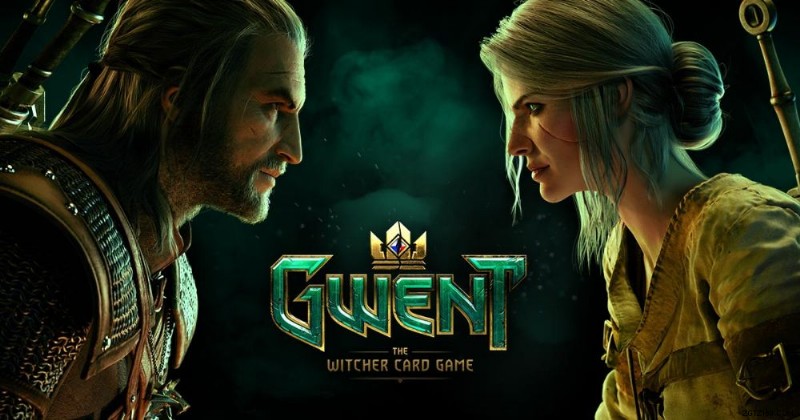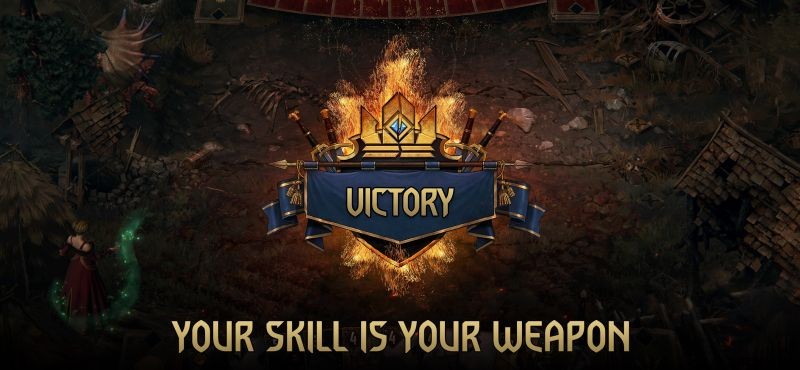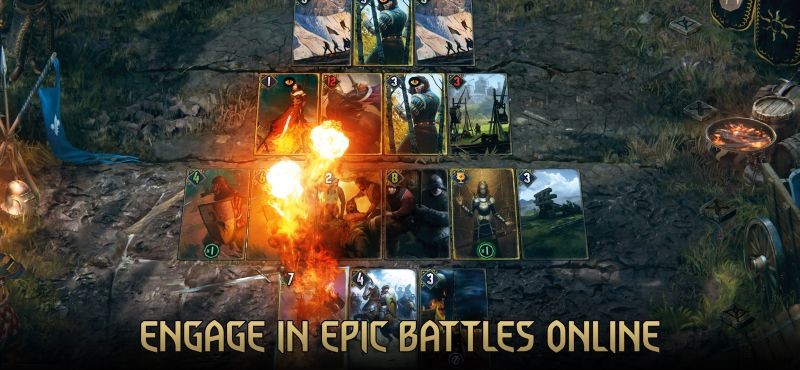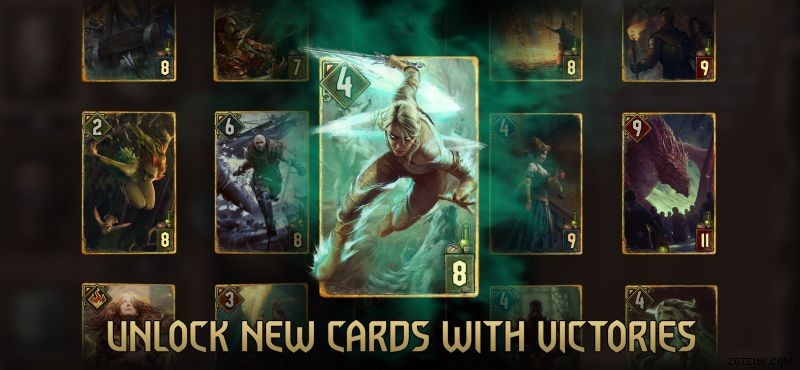
Das lang erwartete Kartenspiel im Universum von The Witcher ist endlich da! Betreten Sie GWENT:The Witcher Card Game! Deine Lieblingshelden und Fraktionen aus The Witcher treffen in diesem strategischen Sammelkartenspiel aufeinander.
Die Spieler werden im Handumdrehen eine sorgfältige Entscheidung treffen, denn jeder Zug in GWENT zählt! Es ist das Beste der drei, also sind sorgfältiger Deckbau und Kombos der Schlüssel zum Sieg.
In unserem Leitfaden mit Tipps und Tricks zu GWENT:The Withcer Card Game gehen wir auf die grundlegende Mechanik und einige Beispielstrategien für die Verwendung der bereitgestellten Decks ein. Beginnen wir mit unserem GWENT:The Witcher Card Game-Cheats, Tipps und Tricks-Strategieleitfaden zum Erstellen Ihres ersten Decks!
GWENT ist ein Spiel, in dem es um kluge Entscheidungen und umsichtige Geduld geht!
In GWENT kämpfen zwei Spieler in strategischen Kartenschlachten um das Beste aus drei Runden. Das bedeutet, dass Sie zwei Runden gewinnen müssen, um zum Sieger des Spiels erklärt zu werden.

Jede Karte hat eine Zahl in der oberen linken Ecke – dies ist die Stärke der Karte. Alle Ihre Karten werden immer in jeder Runde gezählt und das Ziel ist es, der Spieler mit der höheren Macht zu sein, wenn beide Spieler passen. Wer die höhere Macht hat, gewinnt die Runde.
Wenn eine Runde beendet ist, werden alle Karten zerstört, die derzeit auf dem Spielfeld gespielt werden, und beide Spieler ziehen drei weitere Karten, um die nächste Runde zu beginnen. Das bedeutet, dass Sie einige Karten für die nächste Runde behalten müssen, damit Sie nicht gleich alle Ihre guten Karten ausspielen.
Wissen Sie, wann Sie zurückhalten und alles geben müssen!
Wie bereits erwähnt, müssen Sie sorgfältig abwägen, ob Sie Ihre Hand zeigen, aber nicht alles. Während der ersten Runde entscheiden beide Spieler über ihre Herangehensweise und Sie müssen Ihre Wahl treffen, je nachdem, welche Karten Sie gezogen haben.
Werden Sie gleich Ihre stärkste Karte ausspielen? Oder werden Sie daran festhalten, um die nächste Runde auf spektakuläre Weise abzuschließen? Sie haben die Wahl, aber zu wissen, wann Sie zurückhalten und wann Sie vorankommen, hängt von Ihrer eigenen Intuition ab.
Schauen Sie sich an, was Ihr Gegner tut, und versuchen Sie, sie zu lesen. Werden SIE aufs Ganze gehen? Vielleicht müssen Sie sich verteidigen, oder Sie können es zu Ihrem Vorteil nutzen. Denken Sie daran, dass Sie zwei Runden gewinnen müssen...

Dünnen Sie Ihren Gegner aus, um einen Vorteil daraus zu ziehen!
Eine der gebräuchlichsten Taktiken in GWENT ist das Konzept der „Ausdünnung“. Ausdünnen ist im Grunde genommen der Prozess, absichtlich Ihre weniger wertvollen Karten zu spielen, um Ihre Chancen zu verbessern, in späteren Runden Ihre besseren Karten zu erhalten, wie z. B. Ihre silber- und goldgerahmten Karten.
Ausdünnen ist etwas, das man sich selbst oder seinem Gegner antun kann. Beispielsweise können Sie Ihren Gegner dazu zwingen, sein eigenes Deck absichtlich auszudünnen, indem Sie Ihre starken Karten spielen, und ihn dazu zwingen, mit seinen eigenen zu reagieren, oder Sie riskieren, die Runde zu verlieren.
Dies ist vielleicht die grundlegendste Erklärung für das Ausdünnen, aber es ist eine wirkungsvolle Technik, wenn sie richtig durchgeführt wird. Die Chancen gegen das eigene Deck auszuspielen ist eine Fähigkeit für sich, also denken Sie daran.
Vergiss deine Anführerfähigkeiten nicht!
Basierend auf dem Starter-Deck, das Sie wählen, erhalten Sie eine Leader-Fähigkeit. Die Leader-Fähigkeit kann für beliebig viele Ladungen verwendet werden, dann ist sie – in den meisten Fällen – erschöpft und kann für den Rest des Spiels nicht mehr verwendet werden. Es ist wichtig, dass Sie Ihre Fähigkeiten mit Bedacht einsetzen!
Die in den Starterdecks festgelegten Anführerfähigkeiten sollen die eigentlichen Karten ergänzen, aber wenn Sie Ihr Deck zusammenstellen, können Sie jede beliebige Anführerfähigkeit auswählen. We will go over all of them in the starter deck list.
Decks &Strategies in GWENT

When you complete your first three bot matches in GWENT, you are given access to all five starter decks. This is where things really start to open up, and you can start experimenting with the different faction decks to see what suits your playstyle.
Here, we will go over the sample decks and we will share some basic strategies with you in hopes that you can use them as jumping off points for your own deck builds.
Northern Realms
Leader skill:Inspired Zeal (Charge 3)
Inspired Zeal boosts an allied Northern Realms unit by 1 and grants it Zeal. Zeal lets cards with an Order to be played immediately upon entering the battlefield.
The Northern Realms starter deck focuses on strength in numbers. Many cards like Nenneke, Anna Strenger, and Temerian Drummer focus on boosting allies. This deck succeeds when it can places its supporting cards next to its main soldier cards.
Cards like the Siege Tower and Tridam Infantry benefit from being near allies. Specifically, the Siege Tower gains power when it is between two soldier-type units, and the Tridam Infantry attacks a random enemy for 1 damage every time it is boosted.
The Tridam Infantry is amazing when paired with the previously mentioned Anna Strenger and Termerian Drummer cards, as they can constantly boost the infantry, resulting in attacks every turn.
Monsters
Leader skill:Carapace (Charge 2)
Carapace boosts an allied unit by 3 and grants it Shield. Shield protects the unit for one attack.
The gruesome Monsters focus on getting revenge through Deathwish abilities and also consuming each other to grow more powerful.
The best example of this is one of the deck’s gold cards, Ozzrel. Deploying Ozzrel in the melee row allows it to consume one of your opponent’s units in their graveyard, removing them from the match permanently, while powering him up at the same time.
Other cards, like the Celaeno Harpy and the Ghoul are able to consume other units. Some units can only consume allies, while some can only consume enemies, so make sure to pay attention to what their Consume text says.
A few cards like the Archespore and the Harpy Egg have the Deathwish ability, which causes things to happen when the card in question is destroyed. Harpies are spawn from the egg when destroyed and the Archespore damages enemies.
If your opponent is aggressive and likes to attack your cards often, these Deathwish abilities will make them think through that strategy twice.

Skellige
Leader skill:Onslaught (Cooldown 2)
Onslaught is a straightforward skill that damages an enemy by 1.
The aggressive Skellige focus on attacking opponents relentlessly so that they eventually gain the upper hand through Bloodlust, an ability that triggers when a number of enemy cards are missing health.
A majority of the cards have the Bloodlust ability, including the gold card Donar An Hindar. Each card has its own Bloodlust threshold; Donar An Hindar’s Bloodlust ability, which lets him damage an enemy unit by 4, requires at least two enemy units to be already damaged.
Other units are able to take advantage of damaged enemies even if they do not have a Bloodlust ability. The Giant Boar, for example, is boosted by 1 point for every damaged unit. If the enemy team has a lot of units that are hurt, the Giant Boar can single-handedly put you ahead in points.
Let your opponent play a few cards, then damage them slightly to take advantage of the Bloodlust abilities. The more you attack, the more power you will gain!
Nilfgaard
Leader skill:Strategic Withdrawal
Strategic Withdrawal moves an allied Nilfgaardian unit to your hand and boosts it by 2, then you are able to play a card.
The powerful Nilfgaardians rely on allies to empower their abilities, like the starter deck’s gold cards Serrit and Auckes. These two cards deal damage and lock enemies respectively, but if you play one with the other in your hand, their abilities are amplified to tremendous degrees. Serrit deals 4 damage instead of 2, and Auckes is able to lock an enemy and all copies of that enemy on the battlefield.
The Impera Brigade is a powerful 3 point card that when summoned into the melee row, will summon all additional copies from your deck alongside it. If you load your deck with these guys, you can give yourself a big point boost seemingly out of nowhere.
The Nauzicaa Sergeant gains a power point every time you play a unit that has the Deploy ability. Almost all of the cards in the Nilfgaard starter deck have the deploy ability, so play the Sergeant early to make the most of it.
Scoia’tael
Leader skill:Invigorate
Boost all units in your hand by 1.
The Scoia’tael starter deck is an all around deck that focus on damage, boosting, and utility. Most of the gold cards like Milaen, Sheldon Skaggs, and Pavko Gale all focus on no nonsense damage dealing. Ida Emean aep Sivney can grant an ally Vitality, which boosts that ally by 1 for as long as Vitality lasts.
This deck features the powerful Incinerating Trap which is invisible to your opponent when played. The trap is automatically activated when your opponent plays a card, damaging them for 5. The trap’s damage is usually enough to destroy most cards on its own, so get ready to play it when you feel the time is right.
The Urihedd Dragoon card can force an enemy unit to move into the opposite row. It can also be used on one of your allies if they get moved out of their original row. You can disrupt potential strategies since certain cards need to be in a specific row to use their abilities.
With its focus on powerful moves and utility, the Scoia’tael is a great deck to start off with.

Play them all and build your own deck!
We recommend that you take all five starter decks for a spin at least once. That way, you will grow more familiar with the cards and possible combos. With this knowledge in hand, you will be able to craft your deck from the ground up!
Each card has a provision number on it, and your deck cannot exceed a certain threshold of provisions. The more powerful cards, like the gold cards, tend to have high provisions so you will need to balance your deck carefully.
We recommend staying close to around 25 cards just like the starter decks do, as this the perfect number to get through a round while being able to slightly control what you will draw next.
If you have more cards than this, it will be much harder to influence what you will draw next and get your better gold cards, so be careful when making bigger decks.
That concludes our guide on the basics of GWENT:The Witcher Card Game. If you have any other deck building strategies you would like to share, let us know in the comments below!
